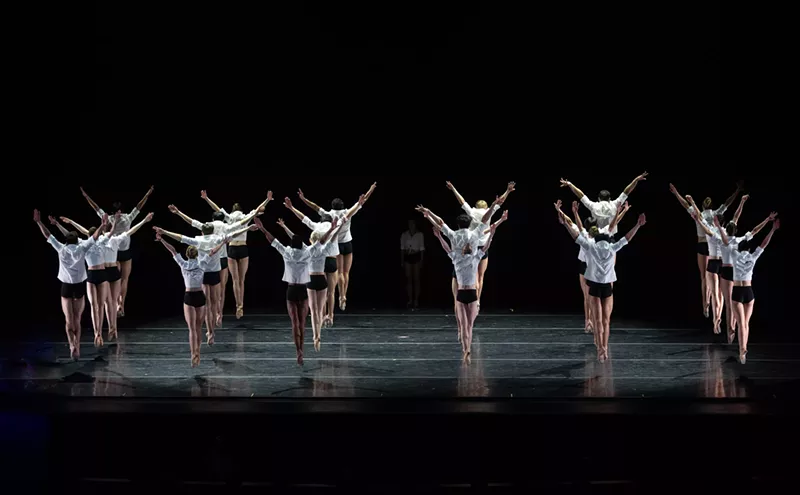Usually these antics play themselves out in the coastal art centers of New York and Los Angeles. But on a recent Thursday night, art lovers got a taste of these developments, Scottsdale-style. Opening simultaneously were exhibitions of the Phoenix-based artist Mark McDowell, at Marilyn Butler Gallery, and Tucson-based painter Hoge Day, at Lisa Sette Gallery.
McDowell, a well-known artist around town, buys into both the aesthetic doctrines and the careerism of postmodernism. Although he is ten years younger, Day is an anachronism by comparison. Hermetic and completely absorbed by his art, he is almost too good to be true. The difference between the two "scenes" at the openings, engendered by the disparate outlooks of the two artists, provided a textbook example of the current state of the art world.
The Butler Gallery was packed with people, black leather and balloons for McDowell's tenth solo exhibition. Since receiving his M.F.A. from Arizona State University, McDowell has been represented by Butler, one of the more influential galleries in Scottsdale. Through exhibitions and high-profile activities in the art community, he's made a name for himself on the local scene. The art mafia, with its bizarre hairdos and black outfits, was in full attendance at the opening. As usual, people were talking more about people than art.
McDowell was also there and, with his pointed zebra-skin shoes, black jeans and tuxedo shirt, he didn't disappoint. He was the perfect image of an Eighties artist, and the perfect host. "I'm nice to everybody," he gushed as he deftly managed to meet and greet three people at once.
Slick and seductive, the art on the walls fit the opening-night crowd. Adhering to postmodern doctrine, McDowell's artistic vocabulary is one of everyday items painted in a style borrowed from the popular media. His collages and paintings combine images appropriated from advertising, such as screws, combs, cows and cartoon characters. These postcard-size elements are arranged in pun-filled compositions around a central, simplified image.
For instance, the diptych "Chit-Chat" shows a black outline image of a woman on the phone juxtaposed with a similar image of a man. Surrounding the figures are attributes that provide clues to their personalities and an Annie Hall insight into their private thoughts during their phone conversation.
McDowell deciphered the diptych for a delighted gathering of yuppie collectors at the opening. In a staccato delivery that had his audience in giggles--and betrayed his true calling as a salesman--McDowell pointed out that the woman is paired with a tiny picture of an old-fashioned phone while the man is paired with a modern version. The stereotypes continue. The woman is accompanied by an image of flowers, a top hat and gloves, indicating her visions of a romantic night of dancing. However, the man is surrounded by images of bowling pins, a cup of coffee and a screw, indicating his plans for the evening.
Always accommodating, McDowell further explained that his technical skill is derived from his study of printmaking. In fact, in the artist's statement posted on the wall, he wrote, "It is the act of being capable in your craft that allows one to make concepts into tangible objects."
But to save time, he confided, his images are photocopied directly from advertising clip-art and then projected onto a canvas. The technique is common practice among today's avant-garde.
His work serves, as McDowell wrote, to "document this time and place in which I live." That's true, insofar as the imagery of McDowell's paintings is instantly accessible. But after a few minutes, when the viewer has figured out the puns and jokes behind the work, there is nowhere else to go, except perhaps out the gallery door. McDowell is so technically precise and so calculated in his jokes that he leaves little room for the viewer's imagination. Nor does he have any insights of his own. The result is a collection of meaningless references to popular culture. Hoge Day's paintings at the Lisa Sette Gallery, by contrast, have an entirely different effect. His opening gathered a much smaller crowd, decidedly lacking in beautiful people. The small turnout was partly because Day is an out-of-town artist, but primarily because of the kind artist he is.
With his long, straggly hair, batik shirt and scruffy loafers, Day is a refreshing throwback to an era less concerned with self-promotion. His is a more personal commitment to art. Quiet and soft-spoken, Day is more interested in his recent consciousness-raising travels to Indonesia--where he bought his shirt--than explaining or selling his art. When asked about the influence of his travels on his paintings, Day is uncertain. He has no stock answer, and confesses that he has been closely watching his own paintings to see the effect of his wanderings. When not making pilgrimages to the East, Day lives a secluded life on a ranch outside Tucson. He built his own studio and lives hand-to-mouth, working construction when he needs extra money. Although Lisa Sette points out that Day is aware of contemporary movements and recently made a trip to New York, it is obvious that Day's interests lie neither in his career nor the fashionable art scene. Day's paintings are made of junk, which can be off-putting at first. But on top of scrap metal, wood and ugly old linoleum, he paints fascinating images that straddle the line between abstraction and representation. In "Plowed Under Night," a classical head floats amidst fields of color on a beautifully rusted sheet of metal.
Like the modernists, Day relies to a large extent on his subconscious for his imagery. He keeps numerous objects around his studio for inspiration, but the compositions derive from his free-flowing thoughts. For "My Brother's Friend," he set up a still life of bottles on a shelf, as a sort of preliminary sketch to match the composition in his mind. Day's work is open-ended and enduring, both for the artist and the viewer. Once you get past the initial shock of the materials--"My Brother's Friend" is painted on linoleum--you are likely to stay a while. As one visitor at the opening noted, "When I first walked in, I didn't think the work was that great. But then I started to see all sorts of things in the paintings." Shapes and forms continually emerge and coalesce in Day's evocative compositions.
Day's work has been labeled traditional, an appropriate description of painting that relies on formal qualities of color, form and composition. Ideologically, Day harks back to the heroic abstract expressionists who for years labored in obscurity out of dedication to their art. In this way, Day is part of a growing movement of artists, both male and female, who are turning away from the vapid, postmodern, neo-Pop style of the Eighties, and returning to a crafted object and an emotionally charged style.
With his idealism, Day may be clinging to an outmoded view of the art world. Idealism can carry a holier-than-thou prejudice. Why shouldn't an artist seek fame and a financially rewarding career? Yet, in the Eighties, career has overshadowed art. Artists model jeans (Robert Longo and William Wegman, to name two) and Rolex watches (Helen Frankenthaler) in advertisements that focus on their celebrity, not their art. And aspiring artists around the country line up at prestigious art schools that offer not only painting, but classes in self-marketing.
One of the most striking differences between McDowell and Day is the way they perceive the future. Oddly, McDowell announced the content of his upcoming work to viewers at his opening. He seems to be caught in the race, frantically trying to keep ahead of the next batch of talented, ambitious young artists. He is excessively conscious of the progress and future of his work.
Day, however, seems unconcerned about the future. Secure in his vocation and confident in his vision, he allows his art to lead the way.
His is a refreshing outlook and a hopeful starting point for the Nineties.
Paintings and collages by Mark McDowell at the Marilyn Butler Gallery, 4160 North Craftsman Court, Scottsdale, through June 2.
Paintings by Hoge Day at the Lisa Sette Gallery, 4142 North Marshall Way, Scottsdale, through June 2. The art mafia, with its bizarre hairdos and black outfits, was in full attendance. As usual, peoplewere talking more about people than art.
Nor does McDowell have any insights of his own. The result is a collection of meaningless references to popular culture. With his long, straggly hair, batik shirt and scruffy loafers, Day is a refreshing throwback to an era less concerned with self-promotion.
A WRINKLE IN TIME PHOTO--HISTORIAN GETS ... v5-23-90












